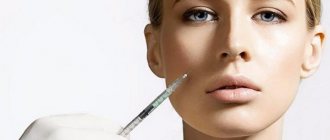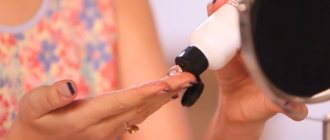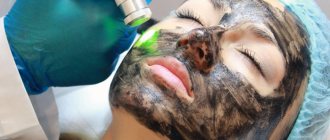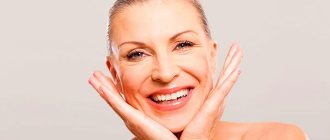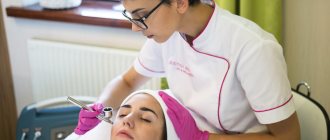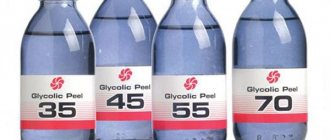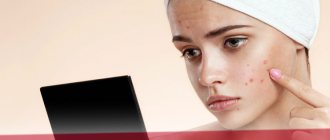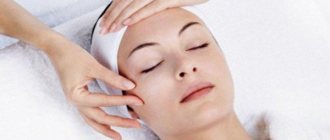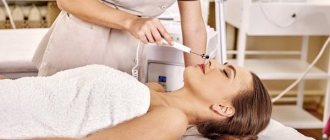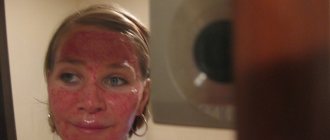Laser facial resurfacing is based on the effect of laser on the facial skin. Leveling the relief of the epidermis is achieved by evaporating soft tissues.
During the procedure, the emitter diffuses deeper into the skin than during chemical peeling.
This eliminates the stratum corneum of the epidermis, and through dynamic cell division, a healthy skin surface is formed.
At the same time, the laser resurfacing technique frees the client from many problems. What can the procedure do?
Characteristics of laser facial resurfacing
Laser facial resurfacing (also known as laser peeling) is a cosmetic procedure that is performed with a laser device and is aimed at removing the dead layer of epithelium.
This is a fairly serious procedure that can cause irreversible consequences: scar formation, hypo- or hyperpigmentation of the skin, loss of fat, etc.
This is why laser resurfacing should only be carried out by an experienced specialist.
In addition to minimizing unwanted age-related changes and eliminating scars, laser therapy activates collagen production.
This happens due to the intensification of natural processes caused by the procedure.
Laser rejuvenation can be safely classified as a progressive method. Every year more and more people undergo this procedure.
Plastic surgeon Barry Weintraub
Manipulation leads to increased blood flow. The difference between gentle laser resurfacing is that the layer of epidermis is removed only from certain areas of the skin.
Exposure of the beam only to microzones reduces the time period allotted for recovery at the end of the skin procedure.
In terms of performance and effectiveness, a cosmetic laser technique can compete with a surgical procedure aimed at correcting defects on the face.
Mesorolling
Microneedling therapy, or transcutaneous stimulation of collagen synthesis, is a procedure that involves renewing the skin through multiple punctures. Such microdamages lead to the formation of new collagen, elastin fibers and vascularization of the dermis and the subsequent reduction of visible wrinkles and scars, and an increase in skin turgor. In addition to a simple mechanical device - a mesoscooter , available for use at home, there is also a hardware mesoscooter technique.
This method of skin renewal is considered safer and less traumatic than laser ablation. Moreover, mesorolling is much less likely to lead to hyperpigmentation or scarring, making it an optimal choice for patients with thin, sensitive skin. Multiple studies prove that microneedling is an effective way to eliminate scars of various origins and wrinkles.
Mesorolling is often used in combination with external cosmetics. Thousands of small skin punctures formed during the procedure are an effective way to deliver active substances to the deep layers of the epidermis.
What laser is used (CO2 or erbium)?
There are 2 types of laser used for resurfacing:
- Carbon dioxide (CO2). Remarkably polishes scars, stretch marks, eliminates skin tumors. The disadvantage of its use is the strong heating (10 µm) of the treated micro-areas. As a result, the skin occasionally suffers from burns, which affects the prolongation of healing.
- Erbium. It emits (5 microns) several micro-rays at once, so the outgoing heat is dissipated and does not cause burning on sensitive skin. This beam helps to achieve a lifting effect on the delicate skin surface of the eyelids and neck.
The rehabilitation period after an erbium laser is half as long when compared with a CO2 laser. In addition, it can be used to treat thin, dry leather.
Dermatologic surgeon Corey Frucht
The laser resurfacing procedure on the face is practically painless for the patient, since gel anesthesia or anesthesia with the use of the drug orally is chosen.
Kinds
Grinding is carried out using several types of lasers, each of which is focused on solving a specific range of problems. The final choice about the use of one laser or another must be made by the doctor, so we will simply describe in a few words their main distinctive features.
Carbon dioxide or carbon dioxide CO2 laser with maximum heating (ablative)
Pros:
- thanks to its significant wavelength (10.6 microns), it is able to penetrate layers of the skin that are inaccessible to other lasers and produce clearly visible changes;
- allows you to get rid of scars, deep wrinkles, spots, benign tumors, and other pronounced imperfections;
- removes a layer of old cells, stimulates the renewal of new ones, provides a lifting effect, evens out skin tone, refreshes, rejuvenates.
Minuses:
- despite local anesthesia and cooling, the procedure is painful;
- strong heating does not allow using the laser on areas with thin or dry skin;
- there is a higher risk of side effects and complications compared to other types of lasers;
- the recovery period takes a long time (2-4 weeks until obvious grinding marks disappear and 2-6 months until complete regeneration).
Difference between ablative and non-ablative lasers
Erbium “cold” laser (non-ablative)
Pros:
- The light flux that the erbium laser generates has a short wavelength (2.94 microns), and therefore is completely absorbed by the very top layers of the skin, without penetrating into its depth, which causes less pronounced damage, and can also be used to treat eyelids and neck;
- fights age-related changes, evens out skin texture and tone, reduces pigmentation, erases medium-depth wrinkles, and ensures that cells produce their own collagen;
- The rehabilitation period takes no more than a week.
Minuses:
- the effect of the procedure is less pronounced than when using a carbon dioxide laser;
- does not cope with scars and tumors, deep wrinkles.
Low-level laser (non-ablative)
Pros:
- the procedure is completely painless;
- the laser beam stimulates cells to produce their own collagen and elastin;
- The effect on the skin is extremely gentle, so there is practically no recovery period required.
Minuses:
- there is no effect of “evaporation” of the stratum corneum;
- The laser works only in the case of the smallest age-related changes; it cannot overcome deep wrinkles and scars.
No matter what type of laser was used, it will take time for visible improvements in your skin to appear. The first favorable changes will make themselves felt already 1-2 weeks after the procedure, and the full effect of resurfacing will be revealed in a few months, when the body has developed its own collagen.
Advantages and disadvantages of laser resurfacing
There are different methods of laser rejuvenation (biorevitalization, blepharoplasty, etc.). They all have their pros and cons. This also applies to laser resurfacing.
At the end of the cosmetic procedure, firmness and smoothness of the skin surface are quickly achieved. The rash, visible wrinkles and irregularities “run away” from the epidermis.
Obtaining a positive result is facilitated by the professionalism of the cosmetologist, who will select the right type of laser for a specific patient.
The erbium laser ER:YAG is gaining particular popularity.
Plastic surgeon Smita Ramanadham
5 main advantages
- Slowing down the skin aging process. The most pronounced effect appears in the area of the nasolabial furrows and near the eyes.
- Elimination of skin unevenness in the form of scars, scars, and age-related dents. Irregularities disappear under the action of grinding. Elimination of such problems occurs upon completion of the course of procedures. Pimples disappear after one session.
- An improvement in tone appears at the end of the recovery period. The face acquires a light, uniform shade without the presence of freckles or pigmentation.
- The narrowing of pores is achieved by updating and strengthening natural processes.
- New cells are formed that are not clogged with fat and dirt deposits.
Conventional laser resurfacing and fractional laser rejuvenation differ from each other. In the first case, the entire area is processed. If fractional photothermolysis (as it is also called) is carried out, specific zones (fractions) are processed.
Plastic surgeon Injili Kitto
Cons of the procedure
- Painful sensations during the event that are not completely removed by local anesthesiology. General anesthesia is rarely used for laser resurfacing.
- Not an easy rehabilitation (2-4 weeks), requiring care for the skin surface established after the course. It is necessary to use prescribed creams, ointments, and sometimes anesthetics. At the end of the activities, the patient may experience: itching of the facial skin, increased body temperature.
A detailed consultation with a cosmetologist will help reduce the possibility of unwanted consequences after sessions.
The specialist will minimize risks and determine whether the client has any contraindications to laser facial resurfacing.
Prohibitions for the procedure include herpes, diabetes, psoriasis, and the acute phase of a chronic disease. Those with wounds on the epidermis, pregnant women and breastfeeding women will be temporarily refused sessions.
Laser resurfacing is attractive because it achieves a multifaceted effect without damaging the skin with injections with synthetic products.
How is laser resurfacing done?
The manipulation is carried out by a plastic surgeon or cosmetologist in the following sequence:
- Having assessed the condition of the facial skin, the doctor determines the type of laser for the event and the type of anesthesia.
- First, he cleans the skin surface 60 minutes before the event with an antiseptic and provides anesthesia.
- Next, the surgeon (cosmetologist) puts on protective glasses for himself and the client and begins grinding. Technologically, a cycle is maintained that is aimed at achieving the goal.
Tell us during your consultation about your preferred result on the specified area of the face.
Deep polishing of wrinkles
This grinding after the preparatory period occurs in the following sequence:
- initial movements of the laser eliminate the outer layer - the epidermis;
- subsequent slow advances of the beam carry out layer-by-layer evaporation of the dermis from different main zones;
- The final laser passes reduce the depth of the nasolabial folds.
This order is followed three times during the procedure. The beginning of each re-treatment is accompanied by the application of an anesthetic gel.
Redness first appears on the treated area of the skin, and at the final stage the skin becomes white.
The 3rd laser treatment sometimes causes blood droplets to appear. The laser vaporizes the skin around the eyes, the collagen produced fills the wrinkled cavities, so the face becomes smooth.
At the end of the session, it is necessary to use healing ointments, painkillers (if necessary), and occasionally use dressings.
The skin recovers in 2-3 weeks. It is permissible to start re-polishing with a laser no earlier than 3-4 months after the incident.
Plastic surgeon Kenneth Francis
What does laser resurfacing of facial scars provide?
Scarring of facial tissue occurs after traumatic situations, surgical interventions and acne on the skin. A carbon dioxide laser is often chosen for resurfacing.
The exception is delicate areas; professionals use the erbium option to carry out the procedure on them.
- Immediately after the procedure, the skin takes on a reddened and swollen appearance.
- A day later, yellow-brown crusts appear on the laser work area. After 5-7 days they disappear on their own, and the swelling disappears.
- After the same period, you can see the result, which is usually positive, which largely depends on the condition of the scar tissue. But at the very least, the edges of the scar will become blurred and its tone will fade. Gradually, even a wide scar will leave no trace on your face.
At the end of the procedure, a burning sensation occurs even after preliminary use of an anesthetic. An intravenous anesthetic is more effective for eliminating a scar on the neck.
After the procedure
After the end of the procedure and the action of the anesthetic substance, a tingling sensation and mild pain may occur. The skin will turn red and develop slight swelling. The degree of discomfort depends on the depth and intensity of the impact, as well as on individual characteristics. All these processes are normal and accompany skin renewal and rejuvenation. After 3-4 days, minor crusts appear on the surface of the treated area, which soon peel off, leaving behind fresh, young and tightened skin without scars, spots and other defects.
After the procedure, it is important to follow the doctor’s recommendations, apply medicinal creams prescribed by him, and not expose the treated areas to additional exposure or trauma. It is extremely important to avoid tanning beds and direct sunlight for a month after resurfacing. Depending on the level of laser exposure, rehabilitation lasts 2-3, 5-7, 10-14 days after superficial, medium and deep resurfacing, respectively.
Elimination of pigmentation
Skin pigments are familiar to 50% of women. The use of creams, decoctions, masks, if it helps to eliminate pigmentation, does so after many years.
And laser resurfacing combats this phenomenon quickly and effectively, since the laser beam, together with the epidermis, also destroys the melanin pigment.
Its excess affects the change in skin color. During the procedure, the colored spots melt. In return, cells are formed that produce and accumulate the natural amount of pigment.
As a rule, 7-10 days after one session the patient becomes the owner of an even skin color.
To get rid of pronounced spots and freckles, a repeat procedure may be required. But even after the initial sanding is completed, their color fades.
Rehabilitation after manipulation includes avoiding sunbathing and using tanning creams.
The result after grinding increases over time. This will require you to wait about a month.
Beautician Sean Patel
Negative effects of laser resurfacing
The skin surface on the face after laser resurfacing sometimes does not please the patient with its appearance. This happens if before the manipulation the skin with the scar was in a deplorable condition.
The depth of wrinkles and the size of pigment formation also affect the result. But a professional will choose the right technique for processing the epidermis and conduct the event at a high level.
It upsets patients that after resurfacing with a carbon dioxide laser, spots and burns sometimes appear on the skin. But there is an erbium laser, and it is safer and more reliable.
You should accept the imperfect appearance of your skin after the procedure for a week. Swelling, wounds, peeling will go away, and the effect of grinding will please you.
If the skin has healed, but the result worsens, you should consult a doctor. Communication with a specialist should not be postponed when:
- Burns and blisters plague me. They are formed when the intense laser exposure is exceeded in sensitive areas.
- Pigmentation forms. This rarely happens due to reasons that are not fully understood. One of the assumptions is damage to the laser dyeing.
- Purulent inflammation occurs. And this is the fault of the patient, who, after finishing the grinding, ignored proper facial skin care. Therefore, it is forbidden to scrape off the crusts that appear: they are eliminated naturally. And the ointments will prevent tissue contamination - they will speed up healing.
Information about the type of laser will be provided to the patient before the start of the session by a professional cosmetologist. He is obliged to provide the client with recommendations for the recovery period, which will allow him to avoid a negative result after grinding.
Anti-pigmentation polishing
Laser resurfacing of hyperpigmentation is comparable to a burn. The deeper it is, the greater the effect.
Removal of pigment spots takes place in several stages:
- Skin preparation . For 2 weeks, do not expose the area with problem skin to ultraviolet radiation. If there is hair on the skin, it must be shaved before manipulation. Before resurfacing, the doctor will apply a moisturizing cream to the treated area to prepare the skin for laser treatment.
- Direct laser action. The doctor selects the length of the beam and the duration of its radiation. Using a special device, the cosmetologist directs the beam to the desired area. The laser unit burns the affected skin at high speed. As a result, elastane and collagen begin to be produced.
- Rehabilitation . For the first 15 days you should not be exposed to ultraviolet rays or go to the solarium. It is necessary to smear the skin with sunscreens that have a high SPF level. The first day there will be slight redness and slight swelling of the integument. You cannot use cosmetics. It is best to treat the skin with panthenol-containing ointments for rapid healing of the burned area.
Face resurfacing (before and after photos are assessed after 20 days) can cause complications. During rehabilitation, a person needs to be observed by a doctor.
Positive results from the procedure
At the end of a well-conducted event, patients note:
- noticeable leveling of scar tissue, reducing the depth and lightening of scars, disappearance of age-related irregularities on the skin;
- leveling wrinkles on the face and increasing the elasticity of the skin;
- improving the overall condition of the skin in the form of narrowing pores, evening out color, destroying age spots and returning a healthy glow to the dermis.
The transformation will occur 7-10 days after the end of laser resurfacing.
To speed up your recovery, many doctors will advise you to undergo a plasma lifting procedure. This is the administration of platelet-rich plasma, which is obtained from the plasma of the person himself.
Dermatologist Brian Chen
Preparation for the procedure
Laser resurfacing is preceded by a consultation with a cosmetologist or plastic surgeon, who assesses the patient’s skin condition, ascertains the absence of contraindications and selects the appropriate type of laser.
You need to prepare for the procedure. The first step is consulting a doctor
If a large area of the body needs to be treated, for example, the face, neck and décolleté, the client may be sent for blood tests: general, biochemistry, HIV and hepatitis C.
2 weeks before resurfacing, avoidance of sunbathing, visiting a solarium, and rough skin scrubbing is required.
The day before the procedure, you are prohibited from drinking alcohol and smoking.
In some cases, the patient may be prescribed a 3-day course of antibiotics or herpes medications, offered to undergo a biorevitalization session to moisturize the skin, recommended for superficial chemical peeling or other options for preparing the face for the upcoming test.
Cost of rejuvenation
The price of laser rejuvenation includes several items: type of laser, level of resurfacing, number of procedures, financial policy and location of the clinic in a particular region.
So, in the capital of the Russian Federation, 1 procedure costs starting from 20 thousand rubles. In the provinces, for example in Voronezh, 1 session will cost at least 10 thousand rubles.
For complete facial resurfacing with a laser for 1 manipulation, you will have to pay an average of 25 thousand - 60 thousand rubles.
Side effects and possible complications
The inevitable consequences of laser facial treatment are swelling of damaged tissues, a burning sensation, which anesthetics help to cope with, and - after a while - itching. These are natural phenomena that you just need to endure.
However, you should immediately consult a doctor if the following forms on the treated surface:
- blisters;
- dark spots;
- suppuration.
These complications may indicate either the incompetence of the cosmetologist who performed the procedure or a lack of skin care on the part of the patient, but in any case, consultation with a specialist is necessary.
New innovative laser device (Opus Plasma)
If you've been thinking about skin resurfacing or are already a die-hard laser fan, you may want to consider one of the latest, first-of-its-kind devices on the market: the Opus Plasma. Technically speaking, it is not a laser, although it does produce laser-like results.
What is Opus Plasma and how does it work?
Like many modern energy-based devices, Opus Plasma is a microablative fractional technology. This means that it only treats tiny areas (fractions) of the skin to control tissue damage and minimize healing time.
Differences? While lasers use light energy, Opus Plasma uses plasma energy. They interact with the skin differently.
The impact of Opus Plasma is limited to the surface of the skin, which is an important differentiating factor between this laser and many other lasers, especially when it comes to rehabilitation.
Dermatologist Shraddha Desai
It's also worth noting that the metal pins on the Opus Plasma device are charged with radiofrequency energy. It is this energy that reacts with atmospheric pressure to create plasma, which "traumatises" the skin, but it also has an additional benefit.
While plasma works more superficially, radiofrequency energy creates heat in the deeper layers of the skin, stimulating collagen production and ultimately helping to tighten the skin.
Who is best suited for Opus Plasma treatment?
Opus Plasma is a good choice not only for those who want to smooth their skin and remove imperfections (wrinkles, acne scars), but also for those who want to solve the problem of sagging and sagging.
It is a particularly good choice for addressing loss of elasticity in the neck.
Facial skin has always responded well to all types of energy-based devices. But the skin on the neck is more difficult to work with because it is more sensitive and delicate.
Opus Plasma has proven itself to be excellent both for eliminating sagging skin on the neck and for treating wrinkles in this area. It can be used much closer to the eye compared to other types of lasers, making it ideal for treating fine lines and wrinkles.
Opus Plasma can be used on all skin types (even dark skin).
Dermatologist Shraddha Desai
Rehabilitation is not long. First there will be swelling and irritation. These side effects last for 24 to 48 hours. Peeling may be bothersome on days three and four, but most people are completely back to normal by days five to seven.
Radiofrequency ablative therapy
The ablative effect of this hardware technique consists of transmitting radiofrequency energy into microscopic punctures produced by a special nozzle. Instant heating of collagen and elastin fibers leads to their contraction and a significant skin tightening effect. Radiofrequency ablative therapy is suitable for skin types I-IV and can be used to combat loss of skin turgor, wrinkles, enlarged pores, pigmentation, acne, telangiectasia and trauma or acne scars. In terms of the duration of the rehabilitation period and the number of side effects, this hardware technique is superior to ablative lasers.
There are several radiofrequency ablative therapy machines on the market today. Among them are Matrix RF, Fractora and EndyMed PRO. In general, according to the results of clinical trials, procedures using such devices are found to be safe, almost painless and effective for improving skin tone, increasing skin turgor and eliminating wrinkles.
Reviews
ANASTASIA, 31 YEARS OLD, SARATOV:
“Because of my wide pores, after much deliberation, I decided to have laser resurfacing. And the procedure lived up to expectations. The skin looks younger and regains its lost smoothness.”
LYUDMILA, 43 YEARS OLD, LIPETSK:
“The scars on my face are from acne I had in my youth.
Blurring the tone increased the severity of the flaws. And laser peeling restored the aesthetic appearance of the face. The skin is smooth and fresh.”
VERONIKA, 26 YEARS OLD, EKATERINBURG:
“I camouflaged my post-acne long and hard, but to no avail.
So I went for laser resurfacing. Recovery lasted 17 days, after the incident I showed up to my friends for the first time. They were delighted to note that the acne pits were barely noticeable. And as the doctor said, they will go away completely after another procedure, which I will undergo in a month.”
Expert opinion
- Cosmetologist
- Surgeon
Anna Avaliani
practicing cosmetologist
With the help of laser resurfacing, you can really make the wrinkles on your face smaller and your skin smoother. In addition, after such a procedure, a lifting effect is observed. The session is carried out without pain.
Aisha Baron
plastic surgeon
To perform this manipulation, local anesthesia is used, which is why people tolerate it well.
The session itself lasts from a quarter of an hour to half an hour. Do not be alarmed by swelling and redness, as this is a normal reaction. Somewhere on the 3rd day, crusts form that cannot be removed yourself; they will fall off on their own in 10 days. Despite the considerable budget, laser facial resurfacing is an effective technique. The patient who applies for the procedure receives new, younger-looking skin. The main thing is to find an experienced specialist and quality equipment.
Tips for skin care after the procedure for speedy healing
We use modern equipment that shortens the rehabilitation period. To ensure healing occurs quickly and with minimal discomfort, you need to cool the skin. For this purpose, use cold compresses every 2-4 hours.
To relieve swelling, hold your head higher. It is better to sleep on a high pillow. Drink more water to maintain fluid balance.
A moisturizer, which is best stored in the refrigerator, helps relieve the feeling of tight skin. The additional coolness is perceived favorably by the skin. You can use decorative cosmetics only after complete healing.
What and how to wash your face after laser facial resurfacing?
For the first three days, it is better to refrain from washing your face with tap water. In the first week, it is recommended to wash your face with saline solution, which is sold in a pharmacy, thermal water or bottled water. Movements should be light and neat. To avoid damaging your skin, DO NOT wash your face with cold or hot water.
